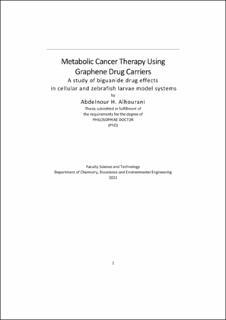Metabolic Cancer Therapy Using Graphene Drug Carriers: A study of biguanide drug effects in cellular and zebrafish larvae model systems
Doctoral thesis
Permanent lenke
https://hdl.handle.net/11250/2831913Utgivelsesdato
2021-11Metadata
Vis full innførselSamlinger
Originalversjon
Metabolic Cancer Therapy Using Graphene Drug Carriers: A study of biguanide drug effects in cellular and zebrafish larvae model systems by Abdelnour H. Alhourani, Stavanger : University of Stavanger, 2021 (PhD thesis UiS, no. 616)Sammendrag
Targeting cancer metabolism is an increasingly important strategy in the fight against cancer relapse. Metabolic drugs belonging to the biguanides family have gained attention in cancer treatment due to their ability to target the mitochondria of cancer cells and the chemo resistant cancer stem cells. However, improvements on the bioavailability of biguanides are still needed in order to incorporate them into a viable and effective treatment regimen.
To first test the effect of biguanide treatment in cancer cell lines, the effect of the metabolic drug metformin was studied in colorectal cell line models using high and low glucose concentration in growth media (paper I). The results showed that the potency of metformin was highly sensitive to the glucose concentration used in vitro. Furthermore, standard glucose concentrations used in cell cultures (25 mmol/L) masked the metformin response compared to physiological glucose concentration (5mmol/L) (paper I).
The bioavailability at target site can be enhanced using nanosized drug carriers to aid in the targeted delivery was studied. Graphene is a 2D carbon allotrope that has been gaining increased attention since its discovery due to its unique properties. Herein, non-oxidized graphene was modified using polyethylene glycol (PEG) to increase hydrophilicity and compared to graphene oxide (GO) as potential drug carriers for the biguanide phenformin. The pegylated graphene nano sheets (PGNS) offered good biocompatibility, high binding affinity, and a pH-responsive release of phenformin which was significantly improved compared to graphene oxide (paper II).
As the toxicity of drug carriers themselves may pose an issue, both PGNS and (GO) were tested for their inherent toxicity in different cell lines and in zebrafish larvae as an in vivo model. Additionally, both drug carriers were loaded with phenformin and tested for toxicity compared to free phenformin in the same model systems. The cytotoxicity and mitochondrial effects of PGNS were lower than that of GO in the cell models tested. PGNS also offered controlled release in acidic pH similar to that found in tumor microenvironments. Moreover, the ability of PGNS and GO to mitigate the side effects of phenformin was confirmed in the zebrafish larvae.
The presented data shows that PGNS have qualities that are sought after for cancer drug delivery, making it an exciting new drug carrier to be further explored for future metabolic treatments of cancers.
Består av
Paper 1: Alhourani, A.H., Tidwell, T.R., Bokil, A.A. et al. Metformin treatment response is dependent on glucose growth conditions and metabolic phenotype in colorectal cancer cells. Sci Rep 11, 10487 (2021). https://doi.org/10.1038/s41598-021-89861-6Paper 2: Alhourani A.H., Førde, J.L., Eichacker, L.A. et al. Improved pH-Responsive Release of Phenformin from Low-Defect Graphene Compared to Graphene Oxide. ACS Omega 2021, 6, 38, 24619–24629, https://doi.org/10.1021/acsomega.1c03283
Paper 3: Alhourani A.H., Førde, J.L., Nasrollahzadeh, M. et al. Graphene-Based Phenformin Carriers for Cancer Treatment, A Comparative Study Between Oxidized and Pegylated Pristine Graphene In Human Cells And Zebrafish. Submitted. This paper is not available in Brage due to copyright restrictions.
Utgiver
University of Stavanger, NorwaySerie
PhD thesis UiS;;616
